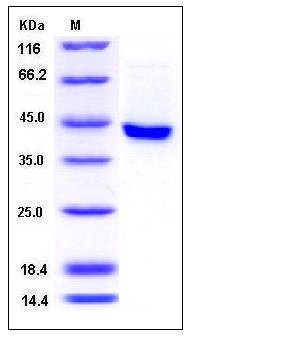Mouse SerpinB8 Protein (His Tag)
CAP-2,CAP2,NK10,ovalbumin,Spi8
- 100ug (NPP3479) Please inquiry
| Catalog Number | P50215-M08B |
|---|---|
| Organism Species | Mouse |
| Host | Baculovirus-Insect Cells |
| Synonyms | CAP-2,CAP2,NK10,ovalbumin,Spi8 |
| Molecular Weight | The recombinant mouse SERPINB8 consists of 385 amino acids and has a calculated molecular mass of 43.6 kDa as estimated in SDS-PAGE under reducing conditions. |
| predicted N | Ala 24 |
| SDS-PAGE |  |
| Purity | > 94 % as determined by SDS-PAGE |
| Protein Construction | A DNA sequence encoding the mouse SERPINB8 (NP_035589.1) (Met 1-Pro 374) was expressed,with a C-terminal polyhistidine tag. |
| Bio-activity | |
| Research Area | Cardiovascular |Blood |Platelet |
| Formulation | Lyophilized from sterile 50mM Tris, 100mM NaCl, pH 8.0 1. Normally 5 % - 8 % trehalose, mannitol and 0.01% Tween80 are added as protectants before lyophilization. Specific concentrations are included in the hardcopy of COA. |
| Background | Serpins are the largest and most diverse family of serine protease inhibitors which are involved in a number of fundamental biological processes such as blood coagulation, complement activation, fibrinolysis, angiogenesis, inflammation and tumor suppression and are expressed in a cell-specific manner. Mouse SerpinB8, also known as Cytoplasmic antiproteinase 2, Peptidase inhibitor 8, SerpinB8, PI-8, SERPINB8 and CAP2, is a member of the Serpin superfamily. SERPINB8 was broadly expressed. In normal neuroendocrine tissues, strongest SerpinB8 expression was detected in islets of Langerhans of the pancreas. Moderate SerpinB8 expression was observed in neuroendocrine cells of the thyroid, adrenal cortex, colon, and pituitary gland. In the pancreas, SerpinB8 is specifically expressed by insulin-producing beta cells, and can be used as an additional diagnostic immunohistochemical marker. Mouse SerpinB8 distribution alters during kidney regeneration, possibly to control a prohormone convertase involved in inflammation or tissue repair. |
| Reference |
